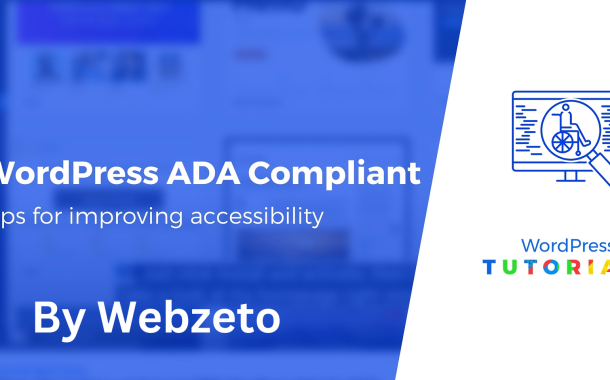Failing to comply with ADA standards not only excludes a significant portion of the population from accessing the website but also exposes businesses and website owners to potential legal risks and lawsuits. Ensuring ADA compliance for WordPress websites demonstrates a commitment to accessibility and inclusivity, enhancing the reputation and credibility of the site while expanding its reach to a broader audience.
Table of Contents
Table of Contents
Why ADA Compliance Matters
ADA (Americans with Disabilities Act) compliance is not just a legal requirement; it’s a moral and ethical obligation. Ensuring your website is accessible means you’re reaching a broader audience, providing equal opportunities for all, and fostering an inclusive online community.
The Human Impact
Consider the story of Jane, a visually impaired college student. She relies on screen readers to access online content. If your website is not ADA compliant, Jane’s ability to access your information is compromised. By prioritizing ADA compliance, you create an internet where everyone can participate fully.
Understanding ADA Compliance
Before we delve into the practical steps, let’s understand the key terms and concepts:
- Accessibility: It means ensuring that people with disabilities can access, understand, and interact with your website.
- WCAG (Web Content Accessibility Guidelines): These guidelines provide a blueprint for making web content accessible. To achieve ADA compliance, your website should adhere to these standards.
- Assistive Technologies: Tools like screen readers, magnifiers, and voice recognition software help individuals with disabilities navigate the web.
Now, let’s take a closer look at how to make your WordPress website ADA compliant.
The Business Case for ADA Compliance
Investing in ADA compliance is not just a legal obligation; it’s also a smart business move.
Expanding Your Audience
Making your website accessible means you’re opening your doors to a broader audience. The 26% of adults with some kind of disability in the U.S. are potential customers who can engage with your content.
SEO Benefits
ADA-compliant websites tend to perform better in search engine rankings. By using semantic keywords and providing comprehensive alt text, you improve your site’s SEO, increasing your visibility to all users.
Positive Brand Image
Companies that prioritize accessibility tend to have a better public image. Your commitment to ADA compliance can boost your reputation and customer trust.
Is My WordPress Website ADA Compliat? How can I Check?
To determine if your WordPress website is ADA compliant, you can follow these steps to conduct a basic accessibility check. Keep in mind that a comprehensive evaluation may require the expertise of a web accessibility professional or the use of specialized tools. Here’s a simple way to get started:
Manual Inspection:
- Keyboard Navigation: Test if you can navigate your website using only the keyboard (use the Tab key to move through links, buttons, and form fields). Ensure that all interactive elements are reachable and operable.
- Alt Text for Images: Check that all images have descriptive alt text, which provides meaningful information about the image’s content or function.
- Headings and Semantic Structure: Verify that your content is well-organized with proper heading tags (H1, H2, H3, etc.) that are used in a logical order.
- Video and Audio Content: Ensure that videos have captions or transcripts for users who are deaf or hard of hearing. Verify that audio content has a transcript available.
- Color Contrast: Check the color contrast of text and background elements to ensure they are easily readable.
Accessibility Plugins:
- Utilize accessibility plugins for WordPress like “WP Accessibility” or “WAVE Web Accessibility Evaluation Tool.” These plugins can identify common accessibility issues on your website and provide suggestions for improvement.
Screen Reader Testing:
- If possible, use a screen reader to test your website’s compatibility. This will help you experience your site as a visually impaired user would.
Online Evaluation Tools:
- Consider using online accessibility evaluation tools like “WAVE” (wave.webaim.org) or “axe” (www.deque.com/axe) to scan your website for accessibility issues. These tools can highlight potential problems and suggest improvements.
Conduct User Testing:
- Involve individuals with disabilities in user testing. Their feedback can provide valuable insights into the usability and accessibility of your website.
Check Against WCAG Guidelines:
- Refer to the Web Content Accessibility Guidelines (WCAG) at www.w3.org/WAI/standards-guidelines/wcag/ to understand the specific criteria for accessibility. Review your website’s content and functionality against these guidelines.
Regular Audits:
It’s important to remember that accessibility is a continuous effort, and it’s always a good idea to consult with experts in web accessibility for a more thorough evaluation. If your website is for a business or organization, and you want to ensure full ADA compliance, consider seeking professional assistance to conduct a comprehensive accessibility audit and make necessary adjustments.
How Accessible Is WordPress
WordPress, as a popular content management system (CMS), has made significant strides in improving accessibility over the years. Its development community has been actively working to make WordPress more inclusive and compliant with web accessibility standards, such as the Web Content Accessibility Guidelines (WCAG).
Here are some key points regarding the accessibility of WordPress:
- Accessible Themes: WordPress offers a variety of themes, including many that are designed to be accessible “out of the box.” These themes often follow best practices for accessibility, making it easier to create an accessible website.
- Accessibility-Ready Theme Tag: WordPress introduced an “Accessibility-Ready” theme tag, allowing users to easily identify themes that meet certain accessibility standards. Choosing such themes can simplify the process of building an accessible website.
- Accessibility-Ready Plugins: Similar to themes, there are plugins specifically developed with accessibility in mind. You can look for and install these plugins to enhance the accessibility of your website’s features and functionality.
- Gutenberg Editor: The Gutenberg block editor, which is now the default editor in WordPress, has made significant improvements in terms of accessibility. It offers features like keyboard navigation and compatibility with screen readers.
- Ongoing Improvements: WordPress is committed to ongoing improvements in accessibility. Developers regularly release updates to address accessibility issues and enhance the overall user experience for people with disabilities.
- Accessibility Team: WordPress has a dedicated accessibility team that focuses on identifying and resolving accessibility issues within the platform. This team also collaborates with the wider WordPress community to promote accessibility best practices.
- Accessibility Handbook: WordPress has an Accessibility Handbook that provides guidelines and best practices for developers and site owners to follow. It covers topics such as creating accessible themes, plugins, and content.
- Third-Party Accessibility Tools: While WordPress itself is working on accessibility, third-party tools and plugins are also available to help improve accessibility on your website. These tools can be used to scan your site for issues and provide suggestions for improvements.
Despite these positive efforts, it’s essential to note that the level of accessibility can vary based on the theme and plugins you use. To ensure your WordPress website is fully accessible, you should select themes and plugins that are explicitly designed to meet accessibility standards, follow best practices, and regularly test your website with accessibility evaluation tools and real users with disabilities.
Tips For WordPress Accessibility
Ensuring accessibility in WordPress is essential for creating an inclusive online experience for all users, including those with disabilities. Here are some tips for improving accessibility in WordPress:
Use an Accessible Theme:
Choose a theme that is labeled as “Accessibility-Ready” or explicitly designed with accessibility in mind. These themes often follow best practices for accessible design.
Alt Text for Images:
Add descriptive alt text to all images, including those in your content and media library. Alt text provides context for visually impaired users and improves SEO.
Keyboard Navigation:
Ensure that your website is navigable using only the keyboard. Test and use the Tab key to navigate through links, buttons, and form fields.
Semantic HTML:
Use semantic HTML tags (e.g., headings, lists, and tables) to structure your content. Semantic HTML helps screen readers understand your content’s hierarchy.
Headings Hierarchy:
Maintain a logical and consistent heading hierarchy (H1, H2, H3, etc.) throughout your content. Avoid using headings for decorative purposes.
Color Contrast:
Ensure that text and background colors have sufficient contrast for readability. Use tools to check color contrast and choose accessible color combinations.
Accessible Forms:
Create forms with clear labels and error messages. Use fieldsets and legends for grouping related form elements. Ensure keyboard accessibility for form fields.
Transcripts and Captions:
Provide transcripts for audio content and captions for videos. This benefits users with hearing impairments.
Links and Buttons:
Make sure that links and buttons have clear and descriptive text, providing context about their purpose. Avoid using “click here” or “read more” as link text.
Content Readability:
Write content in a clear and straightforward manner. Use plain language and keep sentences and paragraphs concise.
Accessible Plugins:
Select plugins that are designed with accessibility in mind. Review their documentation to ensure they follow accessibility guidelines.
Testing:
Regularly test your website for accessibility issues using tools like the WAVE Accessibility Evaluation Tool or screen readers. Address any identified problems.
Keyboard Traps:
Avoid keyboard traps where users get stuck in focus on certain elements. Ensure that all interactive elements can be navigated and excited easily.
Use ARIA:
When necessary, use ARIA (Accessible Rich Internet Applications) attributes to enhance the accessibility of dynamic content, like accordions or sliders.
WCAG Guidelines:
Familiarize yourself with the Web Content Accessibility Guidelines (WCAG) and strive to meet the recommended standards. There are three levels of conformance: A, AA, and AAA, with AA being the common target for many websites.
Regular Updates:
Keep your WordPress core, themes, and plugins up to date. Developers often release updates that include accessibility improvements.
Educate Your Team:
Train your content creators and developers on accessibility best practices. Raising awareness within your organization is crucial for maintaining accessibility.
User Testing:
Involve individuals with disabilities in user testing to gather feedback and make improvements based on real-world use.
Accessibility Widgets:
Explore accessibility widgets and tools that can be added to your site to enhance accessibility features, such as text-to-speech or adjustable font sizes.
Documentation:
Document your site’s accessibility features and make this information available to users who may require it.
Bottom Line
WordPress ADA compliance is not just a legal requirement; it’s a moral and business imperative. By ensuring your website is accessible to all, you’re not only abiding by the law but also reaching a wider audience and enhancing your brand’s reputation. Invest in accessibility, and you’ll create a more inclusive online world, fostering positive user experiences for everyone.
Remember, ADA compliance is an ongoing process. Regularly monitor your website, update content, and seek expert advice when necessary. By following the steps and guidelines mentioned in this article, you can build a website that’s not only accessible but also user-friendly and engaging for all.














